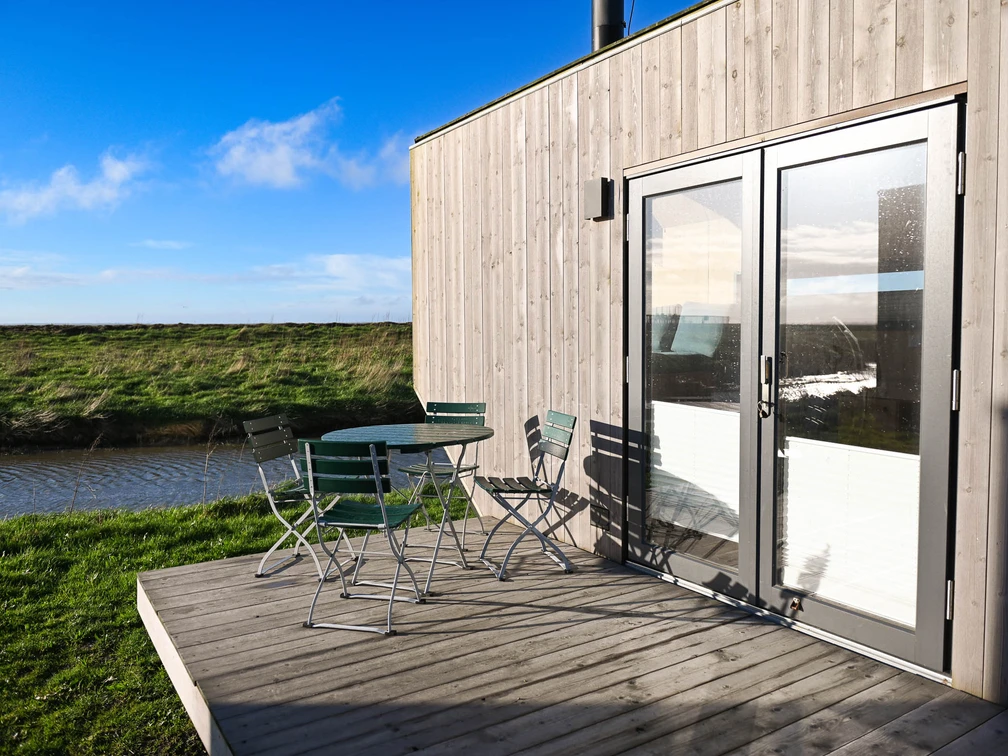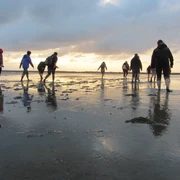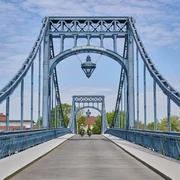Once we get here, Jan explains why he has just stood fully clothed in a shower cubicle to explain to me how it works. Because I wasn't actually that far off the mark with the space rocket. After all, the shower is a model that NASA also uses on board its spaceships. And what would such an astronaut shower be doing in a tiny house? "It recycles the water during the showering process, saving 90 percent of the water volume and 80 percent of the energy," explains the man in the blue sneakers and quilted jacket. Jan Sadowski is the managing director of the start-up Green Tiny Houses. A company that manufactures Tiny Houses and places them in special natural locations throughout Germany to rent out to guests. The highlight of the concept is that the houses are designed to be one hundred percent sustainable in terms of their energy and resource consumption.
Jan is now sitting in front of the large panoramic window pane of the house, which looks like a large mirror of the landscape from the outside and offers a view of nature from the inside. The blue and black sofa on which he has made himself comfortable can be converted into a sleeping area for two guests at night, he explains, just as a cow comes running into the picture behind him. It stops right on the other side of the window and starts chewing its cud. It's a sight that makes me laugh, while at the same time I feel infinitely calm. "I think the special thing about the Tiny Houses is that we have created a place where we can bring sustainability to life," explains Jan. "And that starts with bringing people closer to nature," he says, pointing to the view of the greenery.
As I explore the house, I notice a small pane of glass in the wall, behind which I can make out what looks like threads of brown paper. I've seen this somewhere before. "Seaweed," says Jan with a grin, who has noticed my brooding expression. He explains that the Tiny Houses are insulated exclusively with natural materials, such as sheep's wool or seagrass. "This has the added advantage that seagrass absorbs moisture from the air and releases it again when necessary. This has a positive effect on the indoor climate," he adds. He had the glass installed so that the tenants can see what is hidden behind the light wood paneling, the grain of which adorns the walls from the cork floors to the ceiling with fine brown lines and knotholes. The wood was also treated with natural oils instead of chemicals so as not to pollute the air with toxic fumes.
The more I look around, the more impressed I am with all the creative, sustainable solutions. Because you can see in every corner that someone has put some thought into it. In the bathroom, next to the astronaut shower, I find a combustion toilet that works completely without water. Instead, when I press a button and close the lid, everything falls through a hatch into a closed combustion chamber, where it is incinerated at 600 degrees. All that remains is an ash residue, which is germ-free and can even be used as fertilizer. In the kitchen, I discover a filter system that purifies the water in the sink so well that you can drink it without any problems - no water from plastic bottles needed. Even the towels save water and energy. This is because they are made partly from birch wood, whose antiseptic effect inhibits the growth of bacteria. "This means you can use them for longer before they need to be washed," summarizes Jan. And of course, the guest folder is also digital to save paper.
I'm busy admiring the stairs, which can be rolled under the sink worktop to save space, when I'm interrupted by the loud "moo" of a cow. We step out onto the small wooden terrace outside the front door to see what's going on. But the spotted four-legged friend has already turned back to the green blades of grass in the cow pasture. As I breathe in, my lungs fill with the deliciously salty taste of the sea air. Geese pass by in formation in the sky and we trudge off across the damp green meadow towards a second Tiny House, which, according to Jan, has a few special extras to show off. As we step through the black-framed porch door into the interior of the house, my gaze immediately falls on the asymmetrical large window that frames the landscape as if it were a large painting. Another eight windows fill the room with light, making it appear bright and spacious. At the sight of the wide window sills, I immediately want to put the silver kettle on the gas stove and snuggle up in the blue cushions with an East Frisian tea. My desire for coziness is at least partially fulfilled when Jan turns to the fireplace in the middle of the room and starts piling logs into it. Just a few minutes later, the small room slowly fills with warmth and the sound of crackling flames and cracking wood. Another cow trots past outside the window and in the distance, the blades of a few scattered windmills slowly turn their circles.
And Jan has another ace up his sleeve, which he skillfully pulls out of his sleeve when I want to know what's in the small wooden house that stands on black stilts at the edge of the grounds. "A sauna," he says, as if there's nothing wrong with an ecologically built sauna with panoramic windows in the middle of nature. At the start of the next season, guests will be able to sweat and relax here after a mudflat hike with a view of the salt marshes and then make themselves comfortable in front of their fireplace in the Tiny House. "Many people have the feeling that sustainability automatically means doing without. That doesn't have to be the case. You can make conscious use of resources and still enjoy a high-quality vacation," says Jan, as he lets his gaze wander contentedly over the Tiny House Village. He looks as if he is already thinking about the new guests who are arriving this afternoon. Jan Sadowski is sure to demonstrate the astronaut shower to them too. And hopefully he will stay dry this time too.
Good to know
Hotel information
| Number of beds | 80 |
|---|---|
| Minimum length of stay | 1 |
Payment methods
Contact person
Milena
License (master data)
Nearby






